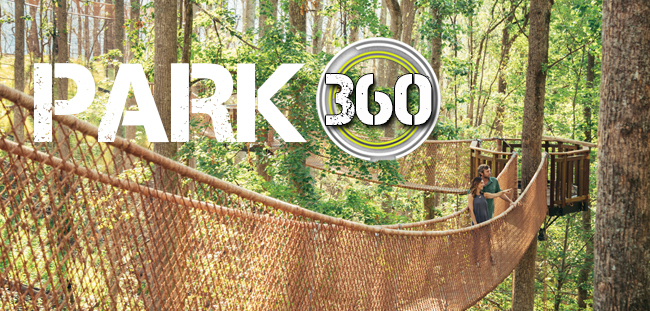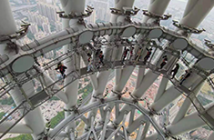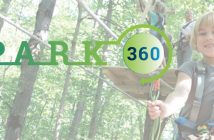When it comes to feats of engineering in the aerial world, the Swiss have gone straight to the head of the class. In July, what has been billed as the world’s longest suspension footbridge, a 1,600-foot span connecting hiking trails in Grächen and Zermatt, opened in the Swiss Alps. Built with wire cables and a metal grid as a walking surface, the Charles Kuonen Suspension Bridge is just 26.5 inches wide, hangs almost 300 feet above the valley, and serves impossibly beautiful views of the Matterhorn and the rest of the Bernese Alps.
The Kuonen Bridge has relegated Skybridge in Sochi, Russia—opened in 2014 shortly after the Winter Olympics—to second-longest status. But Skybridge is still pretty high up there: the 1,400-foot Skybridge hangs 680 feet above the valley at its highest point, enabling bungee jumping for those looking for more than just a stroll through the mountain air at breathtaking heights.
Skywalks, or suspended footbridges, are also beginning to gain popularity in North America as park operators and others appreciate the simplicity and safety of the concept. Like a canopy tour, a skywalk can bring a wide range of people into a natural environment they have never before experienced, whether in the tree canopy or in a world of unobstructed mountain scenery.
Typically built with roughly four-foot sidewalls of rope or metal-cable mesh, skywalks present virtually no chance of falling or serious injury. Helmets or other safety gear aren’t required, nor are guides or other safety personnel. Anyone who can walk, from age two to 92, can do it.
Strolling Above Gatlinburg
That was certainly a major appeal for the folks at Anakeesta in Gatlinburg, Tenn. Gatlinburg is a thriving tourist destination, drawing 13 million or so visitors a year. The Great Smokies National Park is the major draw, but many other attractions—e.g. Dollywood in neighboring Pigeon Forge—crowd the vicinity. What could Anakeesta offer to compete in that saturated market?
Opened in September, Anakeesta is a $30-million mountaintop development with several highly accessible activities: a walking village, a nature-oriented playground, zip lines, and a canopy walk featuring a series of suspension bridges. This creates an everybody-into-the-pool atmosphere. “We are trying to hit the mass of the tourist market,” says Bob Benz, Anakeesta’s owner and managing partner. “We looked at ropes courses or aerial adventure parks and decided that wasn’t our clientele.”
Also, there was a need for an activity that could handle a large visitor volume, given Gatlinburg’s popularity. Anakeesta saw 40,000 visitors in the month of October alone, according to Benz. Unlike, say zip lines, where participant numbers are restricted to just a few people at any one time, the capacity for a skywalk is virtually limitless. In fact, the proprietors of Skybridge in Sochi claim, perhaps with some boastful hyperbole, that they can host up to 30,000 people at the same time.
Anakeesta hasn’t seen that kind of visitor volume, but the point is made. Benz says that each of the 16 suspension bridges that connect fixed tree stations can easily handle six to eight people at a time, and for a one-way walk that takes the average person roughly 15 minutes to complete, Benz says there is never a wait.
Another attractive feature of the Anakeesta installation is that it requires relatively little supervision or guidance. The main need for staff, says Benz, is to “manage behavior.” The bridges can sway laterally, so they are not well-suited for rambunctious hijinks.
The whole purpose of the walk is decidedly mellow. Anakeesta’s mission, according to its web site, is to “immerse guests of all ages in the beauty and adventure of nature.” A chondola (a chairlift/gondola hybrid) carries visitors out of the bustle of Gatlinburg proper to the semi-wilderness of a mountaintop setting; the skywalk, at 40 to 60 feet above the ground, then accentuates the experience of being in the forested mountains.
Many Forms of Success
There are many variations on the skywalk/suspension footbridge concept. The traditional rope-and-wood variety summons images of Harrison Ford taking on evil villains over crocodile-infested waters in Indiana Jones and the Temple of Doom. But such old-school construction is more the exception than the rule, with cables, metal-mesh sidewalls, and metal or composite walking surfaces being the norm. And while walkways might have some lateral sway, recent installations won’t test of the kind of balance and nerve that confronted Indy.
Capilano Suspension Bridge Park in Vancouver, B.C. presents a true skywalk medley. The original suspension bridge that gives the park its name was built of hemp rope and cedar planking in 1888. While wood planks are still incorporated on parts of the bridge, metal cables and sidewalls of wire mesh provide a much sturdier structure than the original. The 450-foot-long bridge is suspended 230 feet above the Capilano River.
In recent years, the park has added companion walks—a treetop adventure, in 2004, incorporating a series of suspension bridges, built primarily of wood planking and cable sidewalls, and, in 2011, Cliffwalk, secured by bolts and cables to cliffs above the river. The purpose of all three: for “guests who want to get deeper into the forest,” says Stacy Chala, the park’s communications manager.
As at Anakeesta, the idea at Capilano was to offer easy activities for a broad variety of visitors, numbering a million annually, according to Chala. Again, being able to handle a large volume of guests at any one time was critical. While at many points along the way there can be the potentially unsettling illusion of walking on air, Chala labels it all a “very safe activity.” One drawback: the walkways are too narrow for wheelchairs.
The Morris Arboretum in Philadelphia has added an unusual twist to the elevated walkway concept. The Arboretum opened Out on a Limb, a series of fixed, connected walkways totaling about 200 feet in length, in 2009. The idea, says Anthony Aiello, the arboretum’s director of horticulture, was to give visitors “a feel of what it’s like to be in the canopy.” Nothing especially unusual there.
Where Out on a Limb leaves familiar territory is with its Squirrel Scramble—loose, hammock-like nets between the sides of the walkway and adjacent trees. The loose netting allows those inclined—primarily kids—to walk, bounce, roll, run, skip, and play in an elevated forest environment.
Owned by the University of Pennsylvania, the park’s stated educational mission is to “promote an understanding of the relationship between plants, people, and place.” That mission, says Aiello, is aimed at a “multigenerational” audience, meaning kids (not just college students) are part of the guest constituency. To attract more kids, having some fun activity—i.e., the Squirrel Scramble—made sense. And indeed, after Out on a Limb was opened, “we did see a fairly significant boost in attendance,” Aiello says.
A Sensible Addition
So skywalks can vary in length, height, building materials, structural rigidity, and so on. But a few shared principles apply. For starters, they are a sensible installation at parks with a wide demographic profile and the potential for a high volume of visitors. If they can work at parks with annual visitation of a half million to a million, they can presumably work almost anywhere.
In addition, safety is a major plus. As Aiello says about Out on a Limb, the idea was to create something that was “not risky but gives the perception of risk.” While guests might be suspended in the tree canopy or high above a river gorge, the chance of any sort of injury is exceedingly small. Benz says that at Anakeesta, the only minor injuries have been the result of a couple of slip-and-falls on the downward stairway leading to the skywalk.
Finally, this can be, for the most part, a self-guided activity. If the objective is to give guests an appreciation of nature, signage and informational panels are probably a good idea. But staffing needs, except, perhaps, guides for school groups and the like, are minimal to non-existent.
Skywalks aren’t necessarily cheap, though. Cliffwalk in Vancouver cost C$4.5 million, for example. And because all of the parks featured here charge a single, everything-included entry fee, it’s hard to measure a per-installation return on investment. But for an activity that has proven to work well with a large and demographically varied audience—and thus expand a park’s potential customer base—a skywalk can be a smart way to go.






